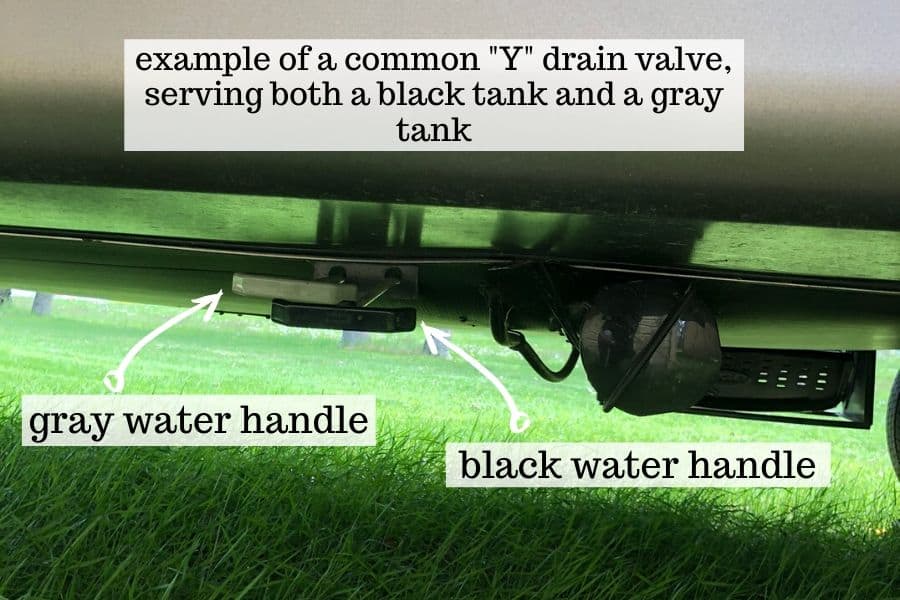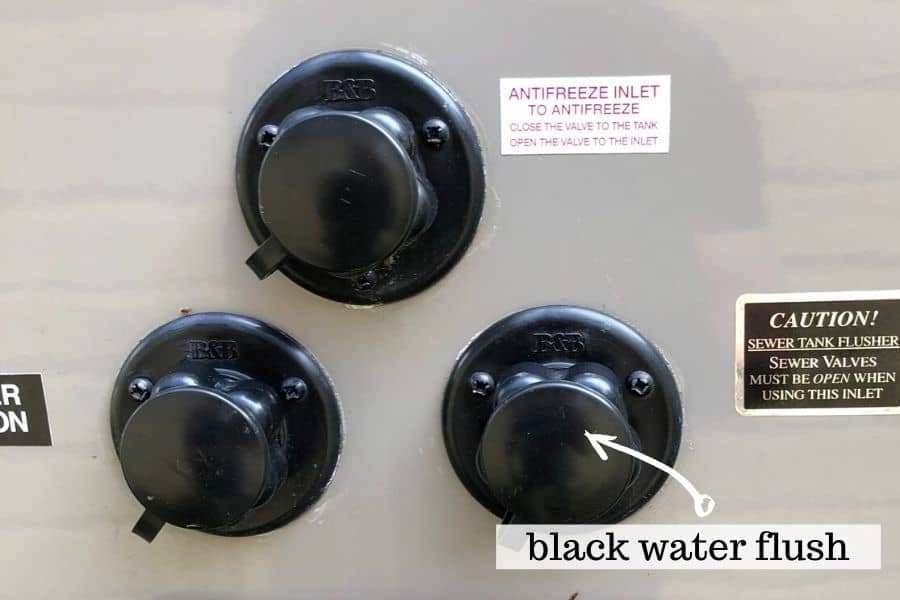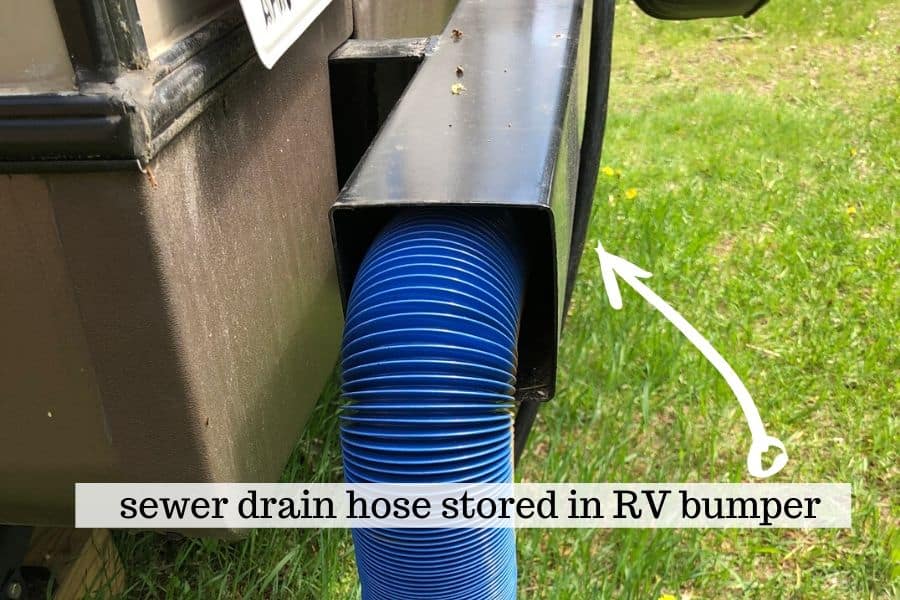How To Empty Your RV Holding Tanks: RV Basics reviews the fundamentals of draining and flushing your RV holding tanks - everyone's least favorite task - especially while on vacation, right? We show you how to empty your wastewater tanks as quickly and efficiently as possible.
Jump to:
How To Empty Your RV Holding Tanks: RV Basics
Overview
Most RVs are equipped with two types of wastewater holding tanks: “Black Water”, which holds the discharge from your rig's toilets, and “Gray Water”, which receive the drainage from sinks and showers. Most rigs have one tank for each; larger units with widely separated discharge points may have multiples.
The outlet points are normally located on the “street”, or driver's side of the rig. Often there may be a “Y” where tanks of different types share a single outlet connection, with discrete valves controlling individual tank discharge - this simplifies the process. Be sure to locate your drain valves before proceeding to the dump station so your rig is properly oriented for dumping.
Supplies and accessories needed:
- Sewer drain hose, at least 20 feet long. These should include end caps for storage; most come so equipped. Hoses are available from your local RV dealer, home improvement and other large scale retailers, or on-line. Here's a link to give you an idea of what they look like: RV sewer hose.
- Black water holding tank rinse hose. Do NOT use your drinking water hose for this! We recommend a self-retracting hose to save space, something like this: RV water hose.
- Disposable latex gloves. Though not strictly mandatory, these can help keep your hands relatively clean and sanitary. You can find these at auto parts stores, drug stores or on-line. Gloves.
Pro Tip: We keep disposable latex gloves, paper towels, and hand sanitizer in a kit with other items in a RV storage compartment. These are all handy items to have on hand.
The Preliminaries
- When ready to depart the campground, or if a full tank requires it, pull your rig into the camp dump station. Locate the rig aligning the dump valve locations so all drain points can be connected to the dump station drain using your sewer hose (your travel partner can help). If that's not possible due to rig layout, you'll need to reposition your rig between tank emptying tasks so your hose can reach the dump station drain.
- Before starting, don a pair of your disposable gloves.
Flush Black Water Holding Tank
Black Water Tank Drain and Flush (do this BEFORE gray water tanks)
- Remove your sewer drain hose from storage, remove the caps.
- Make sure your dump valve for this tank is closed - if it's open you will get an unpleasant surprise when you loosen the drain cap! Disconnect the drain valve cap from the black tank drain outlet. Note this may be a valve devoted to the black water tank or in a "Y" configuration to serve a black water tank and a gray water tank.
- Next, connect one end of the sewer hose to the drain outlet, and the other to the dump drain. The hose uses a push and twist-action to connect to the tank outlet, just like the drain cap covering the outlet is attached. Many sewer line hoses include a translucent elbow which allows easy monitoring of the drain progress - these really help.
- Now open the drain valve. Black tanks use a black “T” shaped handle. Depending on the valve orientation, pull the handle towards you or away from the valve body to open it. Be sure to open it all the way!
- Allow the tank contents to drain via the hose. Progress will be evident through hose pulsing and sounds of water flowing. Be patient – this could take several minutes based on the volume to be removed.
- While the tank is dumping, connect one end of your rinse hose to the water supply of the dump station and the other to the black water rinse hose inlet on the RV. When the dump appears complete, open the water valve for the rinse hose and allow water to spray into the holding tank. This should help encourage any remaining debris to exit. Run the water for 3-5 minutes, and allow the loosened contents to leave the tank. Turn off the water, disconnect the rinse hose and allow it to drain out. Close the black tank drain valve by pushing it in or moving left or right, opposite of the direction you used to open it.
- In the event your rig has another black water tank, repeat steps 2-6.


Flush Gray Water Holding Tank
Grey Water Tank Drain (ALWAYS do your gray tanks last)
- Connect the sewer drain hose to the gray tank outlet. If the gray tank shares an outlet with a black water tank, you're already set. Ensure the exit end of the hose remains in the dump area drain.
- Open the drain valve. Gray tanks use a gray “T” shaped handle. The operation may require pulling the handle towards you or to the left or right, depending on valve body positioning.
- Wait for the tank to empty. Like the black water tank, the time required to do this depends on tank volume. Usually, this will take 4-5 minutes. Gray water tanks do not include a rinse capability as black water tanks do. Once the tank is empty, close the drain valve by moving it in the direction opposite to that used to open it.
- If your rig has another gray water tank, repeat steps 1-3.
- Remove the sewer drain hose. Take a few minutes to be sure it is completely empty – we suggest positioning it in a “U” shape, then place the ends in the dump area drain for a few minutes with the middle of the "U" slightly elevated. Replace the end caps once the hose is fully drained.
- Replace all the drain valve caps removed for the drain/flush process on the RV.
Pro Tip: The sequence of tasks as defined is important in helping keep your sewer drain hose relatively clean. Dumping black tanks first, then gray tanks help keep your sewer hoses odor-free!
Wrap Up - after all holding tanks are emptied
- Store your flush hose and sewer drain hose. Many RVs have a square rear bumper with removable caps that is perfect for storing the sewer line.
- Inspect the rig to ensure all water inlet and drain caps have been reinserted correctly.
- Remove and discard your gloves, and thoroughly wash your hands. Safety first!

Drain RV Fresh Water Tank
Fresh Water Tank
- If you have have used your internal fresh water tanks (usually because the campsite you're at doesn't have water at each site), and you don't need the remaining contents anymore, it's good practice to drain the tank upon departure (assuming you won't need it before you reach your next destination). Also, if this is your final trip of the season, and the tank has anything left in it, it's good to remove that before storage.
- Because there's no waste products in your fresh tanks, you can drain these pretty much anywhere, even at your campsite. That said, be considerate of those who will be using the site after you depart. If you plan to drop a fair amount of water, it's probably best to do so at the campground dump station.
- Locate the fresh water drain valve. This is typically a simple plastic twist valve under your rig, usually close to the fresh water inlet. Twist the vale to open it - the contents will begin to exit. It's a good idea to open the water faucets in the rig so there's no suction in the lines to retard flow. When the flow stops, twist the valve in the opposite direction to close it.
- To be sure all the water is out, turn on the water pump for the water inside your rig. Open each faucet briefly to allow any water trapped in the lines to exit into the drain. Once all faucets have been through this cycle, turn off the pump. Keep in mind this may result in a small amount of water entering your gray water tank, so if you plan to empty the gray tank you may want to wait to do so until the fresh water tank drain is completed.
Common Questions
What do I need to empty RV holding tanks?
At a minimum, you need a sewer drain hose and a black water flush hose. Sanitary supplies such as latex gloves, hand sanitizer and paper towels are good to have on hand.
What is a gray water holding tank?
The gray water tank in your RV holds the drained contents of your sinks and showers. Since there's no bodily waste included, the general color of those contents is a grayish color - think dishwater, soap, shampoo, etc.
Can I leave my grey water tank open?
Campground policy and common sense point towards not allowing your grey water waste to just run out on the ground around your campsite. Consider also the role the contents of your grey tank play in keeping your drain hose flushed out, so it just makes sense to retain and dump that tank after your black water tank is emptied at the campground dump station.
Is it okay to dump grey water on the ground?
Although there's no bodily waste in those contents, and it probably wouldn't be considered "pollution" per se, there may be cooking residue and other waste that may not smell too nice. Keep in mind this would be exiting your RV right alongside, and you'll likely reach the conclusion this isn't a good idea.
What happens when grey water tank is full?
Most RV rigs contain a monitor inside to allow you to review the relative content level of your gray tank. If you allow the tank to become completely full, you will see the same effect as is common at home with a plugged drain pipe - sinks and showers will not drain out. Time to dump!
How often to dump the black water tank?
The black water tank also has a monitor in the cab showing the relative level in it. You do NOT want this tank to be completely full, as your toilet will overflow... So, rule of thumb, empty this tank whenever it reaches 75% full, and every time you leave your campsite for another.
What happens when black water tank is full?
This is most unpleasant, so we recommend you avoid it. Your toilet will overflow if you persist in trying to flush it when the tank is full.
How to dump RV waste at home. What do you need?
If for some reason you cannot dump tanks at your campground, you may be able to do so at home. Do NOT just open your valves and allow your tank contents to run out on the ground! Also, do not follow the example of the brother-in-law in the movie "Christmas Vacation" and just dump them into the sewer inlet on the street!
Unless you have a private in ground septic system or access to your urban sewer line with an available inlet like that at the campground dump station which you can reach with your dump hose when the rig is parked, you'll likely need to purchase a portable holding tank that will allow you to transfer the contents of your RV tanks into it.
The contents of the portable tank then need to be introduced into the normal sewer systems at your house for treatment. Since these portable tanks are of limited capacity, it may take several fill and drain cycles to complete the job. Given the complexities of this process, it's definitely easier to dump at the campground!
Related Content
More From Our RV Basics How To Series:
- Level Your RV Quickly and Safely
- How to Keep Mice Out of Camper
- How To Set Up Your Campsite
- Hookup Utilities At Campground Connections
Looking For More RV Travel Inspiration and RV Campground Ideas?
- 8 Best Myrtle Beach Campgrounds
- RV Campgrounds in Smoky Mountains
- 8 RV Friendly Campgrounds in The Carolinas and Virginia
- 9 Unforgettable and Scenic US Road Trips
We'd Love To Hear From You!
We'd LOVE for you to help us share this post! Here's how:
SHARE YOUR COMMENTS BELOW
We love your comments - say hello, or leave any questions and comments below!
FOLLOW US ON FACEBOOK
Show your RV's, travel photos, food photos, and favorite campgrounds! We'd LOVE to see them!
PIN OUR PIN
Share our pin and pin on Pinterest!
RV Hacks: How To Empty Your Holding Tanks! Helpful tips & tricks for the best ways to empty your wastewater tanks - everyone's least favorite RV task. Overfull tanks can cause all kinds of unpleasant problems (and odors) - don't let this happen to you! What do you need to empty your gray and black tanks? How can you empty your tanks more efficiently? #rvhacks #rvliving #campsite #rvhowto #rvcamping #RVbasics #RVtipsandtricks #seekingthervlife #holdingtank #RVmaintenance #RV101 #rvwaste







Sylvia says
We just purchased our first camper trailer and found your site very helpful. We haven't taken our trailer out yet but are looking forward to it. Do you have a list of some of the most helpful/important items we should buy to take along?
thervlife says
Hi! How exciting! We do have a post of Toolbox Must-Haves that you should check out. I haven't compiled anything as far as the interior must-haves but will be doing so soon as camping season is nearly among us. In the meantime, if you have any specific questions let me know. I'm happy to help 🙂 -Kori